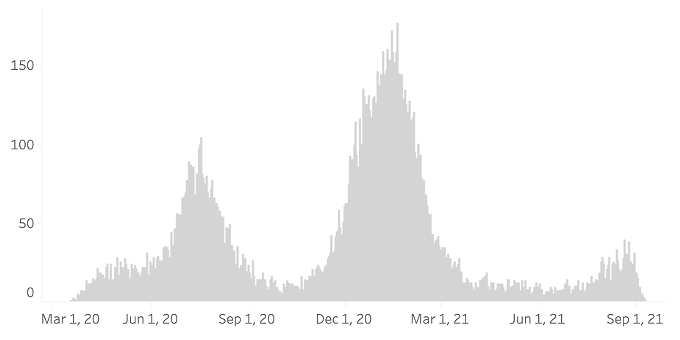The delta wave of COVID cases may be hitting a plateau in Southern Arizona but health officials warn that hospitals remain crowded.
“We appear to be plateauing or perhaps starting to go down,” said Dr. Francisco Garcia, director of the Pima County Health Department. “And although we are not yet ready to have a party, I think that this is, in general, a good sign. This continues to be something that we watch very carefully.”
Garcia noted that Pima County is still seeing more cases than in June and July, before the Delta wave started to rise.
Garcia’s cautiously optimistic assessment was shared by Dr. Joe Gerald, an epidemiologist with the UA Zucker College of Public Health who said case counts in the state during the week ending Sept. 5 were down 19% from the peak hit during the week ending Aug. 20.
Gerald said hospital occupancy was plateauing and it appeared that deaths would remain below 200 per week, but he warned that “this recent improvement could be disrupted in the wake of the Labor Day weekend.”
Gerald also noted a “sharp decline in transmission among children over the past two weeks” and that while it was “difficult to draw causal conclusions, recent mask mandates in certain districts, aggressive case identification and limited classroom closures are likely helping as the steepest declines were among school-age children 5-19 years (old).”
As of Sept. 8, 2,061 COVID patients were in general ward hospital beds, accounting for 24% of capacity. A total of 689 beds remained available in Arizona hospitals, according to Gerald. COVID patients occupied another 561 ICU beds, an increase of 2% from the previous week, and an additional 143 ICU beds remained available for COVID or other patients.
“As a lagging indicator, hospital occupancy appears to be plateauing as expected following declining case rates,” Gerald wrote.
Even with the good news, health officials are urging people to get the flu vaccine in response to unexpectedly high cases of seasonal diseases.
Pima County Public Health Director Dr. Theresa Cullen reported 150 influenza cases in Pima County during a press conference on Wednesday, Sept. 8.
Cullen qualified this report by saying there are more cases than this because most people who get the flu won’t be tested and will be treated by their healthcare provider before a case can be reported.
“As we enter this flu season, we remain concerned that we will see an acceleration of the cases compared with last year,” Cullen said. “It’s important for people to remember that you could get COVID and influenza at the same time.”
Cullen recommended Pima County residents receive both the COVID vaccine and the flu vaccine in the next two months to prepare for winter viruses. Flu vaccines are readily available throughout Tucson at local pharmacies and some grocery stores like Fry’s.
Cullen said two cases of the Mu COVID variant have been confirmed in Pima County. Mu has been deemed a “variant of interest” by the Centers for Disease Control. The Delta variant is the most prolific variant in the United States and is labeled a “variant of concern” by the CDC.
New concern for parents: RSV
Parents should keep their eyes open for the respiratory syncytial virus this season. Chief Clinical Officer Dr. Marjorie Bessel at Banner Health said RSV hospitalizations and ER visits have increased rapidly in the past four days during a press conference on Wednesday, Sept. 8.
“As a reminder, this is an unseasonable spike,” Bessel said. “Typically, RSV is not a big concern during summer months.”
RSV can have symptoms like a normal cold such as fever, runny nose, and wheezing. Most adults overcome RSV within a week, according to the CDC, but it can be dangerous for children. RSV can lead to more dangerous respiratory infections like bronchiolitis and pneumonia.
“We know that respiratory-type viruses and illnesses often circulate when we are together, when we are indoors and have our masks off. So certainly, as we begin to emerge out of some of the behaviors that we put into place during COVID we might see a rise in viral illnesses,” Bessel said. “We are also watching closely the coinfection rates of COVID and RSV. Currently, only 5% of our pediatric COVID patients are also testing positive for RSV. This is quite different than what some hospitals are seeing in other parts of the country like Texas, where about half of their pediatric COVID patients are also testing positive for RSV... RSV hospitalizations and emergency room visits at Banner have increased in the past 3 weeks, with a significant increase over the past 4 days.”
Parents who think their child has RSV are asked to visit a healthcare provider to get accurate testing. RSV and COVID have similar symptoms and children can be infected by both illnesses.
Health officials advised last week that adults who have children or have close proximity with children should get the COVID vaccine to protect kids under 12. The COVID vaccines have yet to be FDA approved for children under 12. ν


